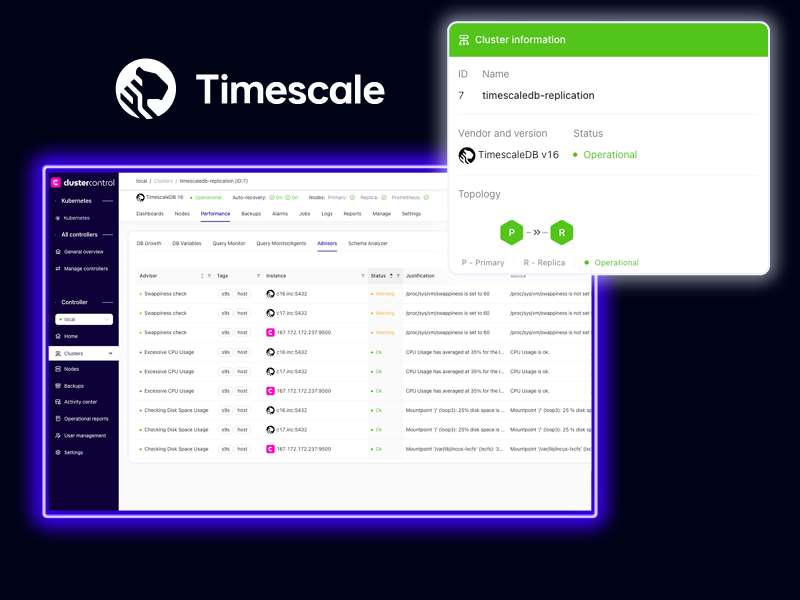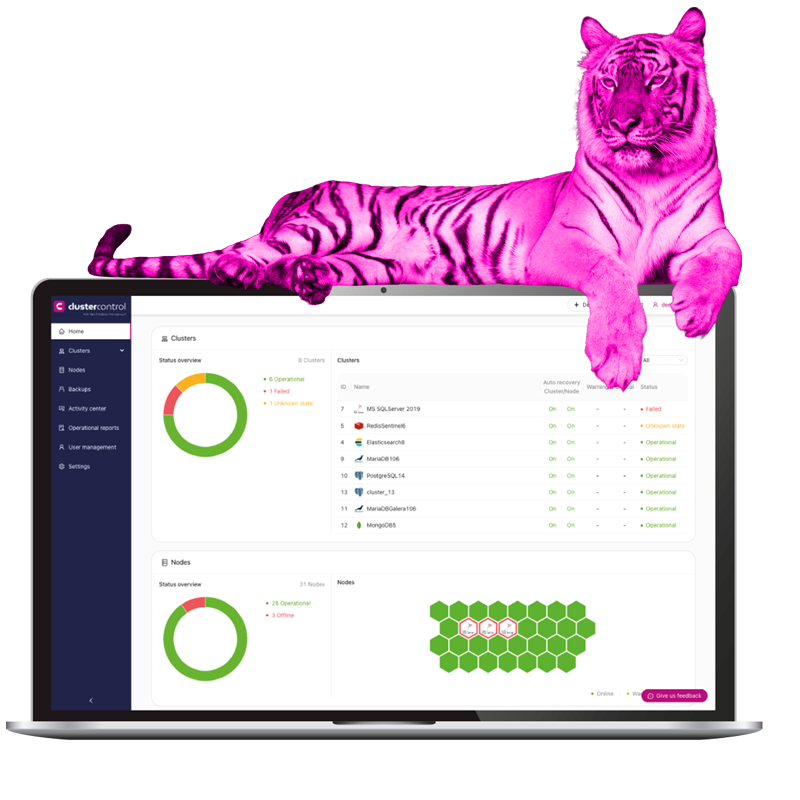Unlock More with ClusterControl + TimescaleDB
Deploy TimescaleDB in One Click
Set up standalone or streaming replication clusters. Includes load balancer options like PgBouncer or HAProxy.
Monitor Time-Series Workloads
Get real-time insights into WAL lag, hypertable activity, query stats, and CPU/memory usage with dashboards.
Backup with PITR Support
Schedule full, partial, or incremental encrypted, compressed backups, and restore to any point-in-time (PITR).
Scale with Read Replicas
Add streaming replication nodes to scale read traffic. ClusterControl automates setup, routing, and high availability.
Automate Ops with Smart Advisors
Monitor and alert on WAL lag, connection limits, replica sync, and more with the help of our built-in advisors.
Secure Access and Compliance
Encrypt traffic via TLS, use LDAP and RBAC to control access, and maintain detailed audit logs across environments.
ClusterControl vs. the Alternatives
ClusterControl is a TimescaleDB cluster manager built for engineers and trusted by enterprises.
| Feature | ClusterControl | Tiger Cloud (Timescale Managed) |
|---|---|---|
| On‑prem & hybrid support | X | |
| Full infrastructure control | Limited | |
| Lifecycle automation | (backup, failover, alerts) | Managed |
| Advanced observability | (advisors, topologies) | Partial |
Still Managing TimescaleDB by Hand? Time to Upgrade.
ClusterControl is the TimescaleDB cluster management platform DevOps teams actually want. Built for engineers. Trusted by enterprises. Made for your infrastructure.
Supported TimescaleDB Configurations
Supported Distributions
Choose from flexible TimescaleDB deployment options and installation methods:
ClusterControl also supports deployments via operating system package managers (e.g., APT, YUM) or custom binaries — for full flexibility.
TimescaleDB (as PostgreSQL extension) – Open-source time-series database built atop PostgreSQL.
Replication & High Availability
Optimize your TimescaleDB deployments with dependable replication and HA options:
Streaming Replication – Uses PostgreSQL’s native streaming replication (asynchronous or synchronous) to enable high availability and read scalability.
Standalone – Single-node deployments without replication.
Severalnines is Enterprise Ready

Reliable
Zero-downtime operations you can count on.

Secure
Data stays protected, at rest and in transit.

Compliant
GDPR, SOC 2, ISO27001 standards.
Managed TimescaleDB features list
| Licenses | |
| Open Source | |
| Cluster management | |
| Deploy / import cluster | |
| Add / duplicate / remove / decommission node | |
| High availability | |
| Load balancers | |
| Automated failover | |
| Asynchronous / synchronous replication | |
| Backup / restore | |
| Full / incremental / partial backups | |
| Backup compression / encryption | |
| Point in Time Recovery (PITR) | |
| Local / cloud backups | |
| Observability | |
| Infrastructure / database / query monitoring | |
| Dashboarding / alerting | |
| Security / compliance | |
| Role-based access control | |
| Key management | |
| LDAP integration | |
| TLS encryption | |
| Reporting | |
| Audit log |
Choose the CC plan that fits your use case and preferred payment terms
Advanced
self-serve
Includes all features from Advanced
- Deploy 2 to 5 node clusters
- Monthly subscription
- Pay with Credit Card
- Community support
starts at€250per node, per month
€0.35per node, per hour
Advanced
Includes everything from Community
- Load balancers
- Scaling and failover
- Backup and recovery
- Monitoring and alerting
- Database user management
- Business hours support
Custom pricing
Enterprise
Includes everything from Advanced
- CC Ops Centre
- Backup verification
- Ops reports and audit logs
- RBAC & LDAP / Active Directory
- Key management, TLS encryption
- Web / email / phone 24×7 support
Custom pricing
Want some CC for TimescaleDB info for later?
Top rated Docs
I currently have a PostgreSQL replication environment and want to enable Timescale. Do I have to create a whole new environment for this and then import it into ClusterControl?
No. Just go to the Nodes tab for your existing PG environment and click on the Actions button far right, and you will see the option “Enable TimescaleDB.”
Can ClusterControl deploy and import both PostgreSQL and Timescale or just one and activate the other?
The choice is yours, but yes, you can deploy (create & import) both technologies independently and isolated from the other. And as many as you’d like.
I don’t know anything about PostgreSQL and have to provide a fully managed Timescale replicated environment. How long would it take me to get it deployed?
Once you have at least two servers with just the operating system installed, it would take around 10 minutes (depending on the server resources) to follow the wizard that installs the software and configures each server with the replication setup finished accordingly.



